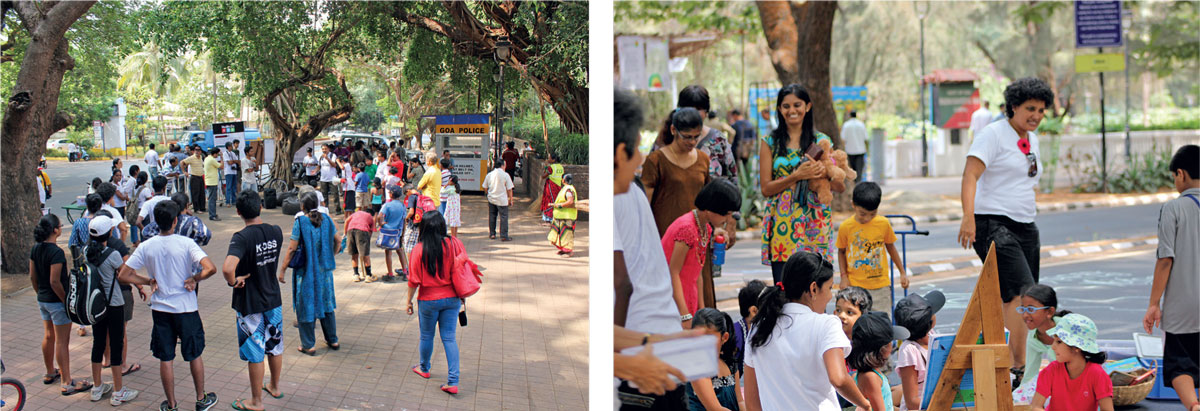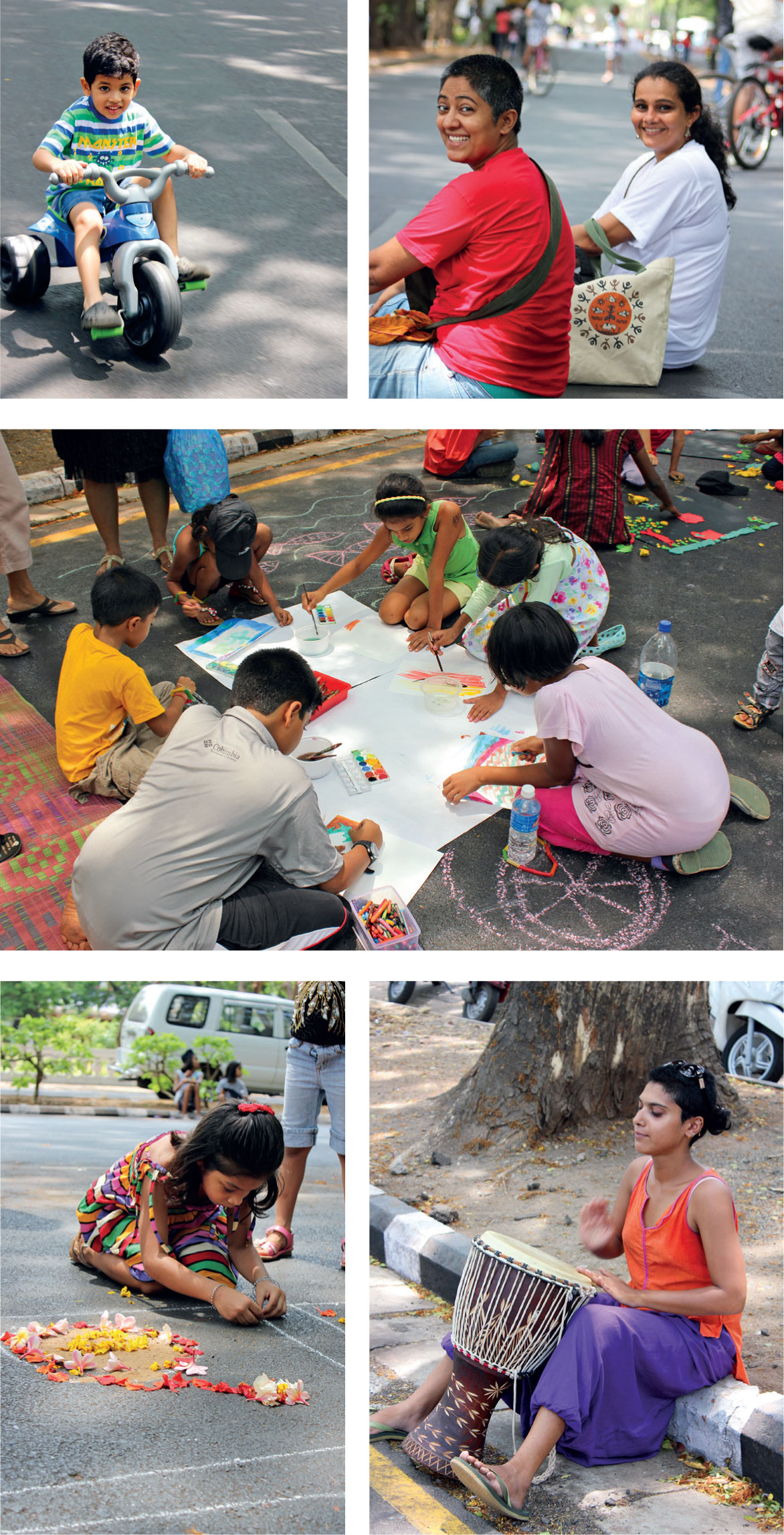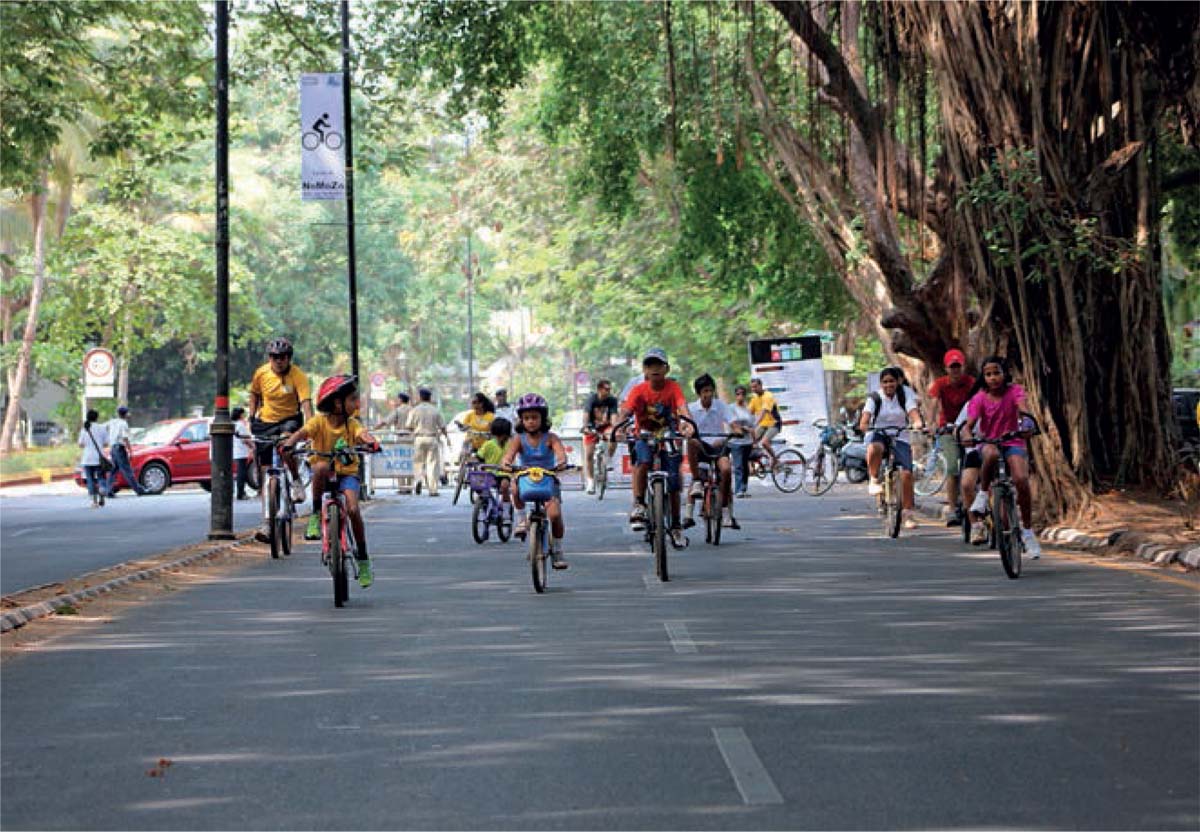Pedestrian-only streets in Goa existed as a tradition when cars were non-existent and people walked. Thereafter, the only modes of transport were buses like carreiras and ferry boats. But with the introduction of cars/private vehicles, pedestrian streets seemed lost to increased congestion, pollution and parking. Amidst this, excellent examples of pedestrian-only streets have thrived in areas like temple precincts and market spaces where private vehicles like cars find no space for intrusion.
So, what is a NoMoZo? A ‘Non-Motorised Zone’ implies a former street that was primarily used for motorised vehicles that changed its use to becoming a pedestrian-friendly and a car-free street. And what is the criterion for choosing a potential street for a NoMoZo? There are many examples: Essentially, a street is eligible for a NoMoZo if it has a character that will only be enhanced by making it a pedestrian street. For example, a temple street or a church square. Visitors to the temple or church, park at the periphery, walk along the car-free street lined with stalls selling garlands, incense and other offerings for the Goddess and the whole experience is enriched by cordoning o the street from moving vehicles and ensuing automobile clatter. Another example is a shopping street or a market area. By closing the street to motor vehicles, the shoppers can freely walk, relax and enjoy the peaceful atmosphere.
Unlike an enclosed mall, shoppers can walk and enjoy the salubrious outdoor environs of a pedestrian-friendly street, allow their kids to walk freely and their old parents to amble without the fear of being knocked down by a speeding vehicle. There are many such examples right from marine or sea/river facing streets to a village tinto (market place) that can become effective NoMoZos.
And what are the benefits of such decongested car-free streets? To begin with, the entire length of the street becomes easily accessible. No cars haphazardly parked, impeding the user to access the utilities on that particular street. The area becomes safer for the user. No vehicles hurtling down the street; senior citizens, children and parents with little babies can safely move around. The street and its air become cleaner; there are no emissions, no pollution and no noise.
As citizens we have been aware of the issues of traffic congestion and mobility in Panaji city and also the possible solutions, as Panaji is a walkable city; small in comparison to other larger metros and its traffic therefore is easily manageable. Consultants to the city development plans had discussed the possibility of a new concept, that of a Car-Free Day in Panaji, but it never took o. The new Commissioner, however, wholeheartedly approved this idea. Similar initiatives across the globe like Cyclovia, Critical Mass and Sunday Street were studied and we began ideating on what exactly to call it wanting it to be unique and Non-Motorised Zone (NoMoZo) won over KaGaNa (Kainch Gadiyo Na! in Konkani). While our long-term focus was on Panaji’s arterial business street, 18th June Road, as the NoMoZo, we decided to do our trial run on DB Marg (one of the main tree avenue streets), which turned out to be a huge success.
The larger objective behind this initiative was simply to make Panaji pedestrian-friendly, cycle-friendly and car-free. This, we hoped, would be possible by supplementing pedestrianization with a good public transportation system on par with similar models in small cities across the globe.
NoMoZo essentially provided a platform where this issue and possible solutions were addressed; it created awareness about the larger issue of mobility in the city and our dependence on cars in the absence of a complementary public transport system.

The first NoMoZo
While all sorts of questions were running through our minds prior to the beginning of NoMoZo – ‘Will this attract crowds?’, ‘Will the traffic be managed well?’, ‘Will we inconvenience a large section of citizens who will not be participating at the event?’, and many more what ifs – little did we realise that despite having no time to publicise the event, we would manage a turnout of a 1000+ participants! The day began early for some of us who rushed on site to place information boards at strategic locations across the event area, doing a recce of problem areas for traffic diversions, collect fresh flowers and other plant matter for artist Harshada Kerkar’s experiment with a natural collage. We gave out information fliers at the market and bus stop and checked points for our designated traffic volunteer positions under the watchful eye of our traffic captains and assistants, all citizen volunteers.
The Mayor and Commissioner placed the NoMoZo board at the barricade at the starting point flagging o the event. Streams of people began with a leisurely walk led by the Mayor accompanied by residents followed by exuberant children. The cycling group came next led by its team leader. A local Quiz Club, with its members, joined the contingent. Then a local children’s library team followed and soon the entire length of the road between the Kala Academy Junction and the second Signal Training Centre was abuzz with kids on cycles rushing to the extreme point under the watchful eye of another citizen volunteer. Roller skaters exchanging their skates, lending them to newcomers and giving tips to beginners created a fun activity. The quizzing gang set up shop opposite the space between the Forest Nursery Gate and the FL Gomes Garden, bombarding the participants with questions. Book Worm, a children’s library, added excitement to the children’s section.
Although we had no time for publicity, as all our permissions arrived on the penultimate dates, the response was overwhelming. The participation over the subsequent NoMoZos increased. The first NoMoZo was really special as it was held on the landmark DB Marg with majestic rain trees and the ambience was completely different, replete with nature forming a calm, green and noise-free setting.
As with all the NoMoZos where the street got completely transformed to being vehicle free, when the traffic resumed, the harsh reality of blaring vehicles, roaring engines and breakneck speed somehow proved to be a nasty intrusion. After the first few NoMoZos, people’s involvement became the driver.
The voluntary nature of the whole initiative, where citizens participated freely, conducted activities and left no traces behind, became a huge draw. Its non-commercial aspect also added value and credibility to the initiative. There was something for each citizen to engage in.

What were our aspirations for our city? We hoped for a cycle- and pedestrian-friendly Panaji. Our priority was to create awareness first and we were happy to have achieved this. We had hoped to impress upon the Government the need for the introduction of a good quality bus transportation system. Once this was done, all changes like pedestrianisation, designated parking areas, paid parking and level pavements would fall into place and our city would be a living example of how positive and constructive change is possible if one has the will to do it. NoMoZo would then be held with increasing frequency till it became a permanent feature of the city.
The third edition of NoMoZo was a huge success with young enthusiasts from schools and colleges landing up at the venue rather early as the Traffic Police, Corporation of the City of Panaji and volunteers hastened to get the area cordoned off, cleaned up and free of cars and two-wheelers. There were more than 2000 people cycling, walking, playing, chatting and also jostling for space in the unexpectedly crowded melee. Kids on their little cycles, teenagers in large groups, parents accompanying tiny tots eager to explore the car-free length of road, senior citizens calmly ambling along, police constables mingling in, the atmosphere and activities just perfect for a Sunday well spent.
The idea of a car-free space was gaining popularity. It simply proved that Panaji and its residents were ready and supported the pedestrianisation of some of its overcrowded streets.
So how will Panaji’s citizens accrue these benefits? All the possible solutions have to slowly fall in place. Where do we begin? What needs to come in first? Beginning at the end of the list, perhaps with a bottom to top approach, can Panaji’s citizenry effect change? NoMoZo hoped to spark that change. It’s comparable to a Car-Free Day or Sunday Street that is currently being observed in many cities in India and across the globe; it seeks to highlight the need to make our cities free of cars and people-friendly. The activities conducted by citizens at NoMoZo are purely incidental to the cause. Our hope was to have a NoMoZo not just on a Sunday but every day. Imagine Panaji car-free every day, forever!



Comments (0)